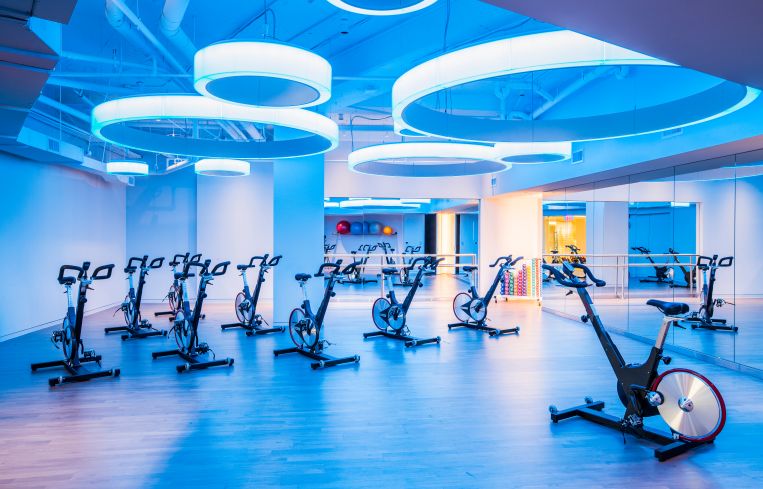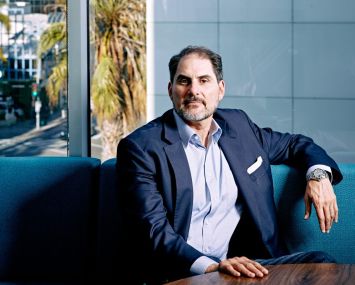Shaping Up DC
A snazzy fitness center in D.C.’s office stock is sometimes the difference between a lease and (power) walking away
By Keith Loria August 28, 2019 5:01 pm
reprints
A fitness center in the office once meant a dank, windowless room inhabited by a few lonesome treadmills in the basement of a soaring complex.
Today it means Peloton. And trainers. And mirror virtual training screens. And landlords sometimes make them one of the first stops on the property tour.
“Gone are the days of a 1,000-square-foot fitness center tucked in the least desirable space in the building,” said Lou Christopher, vice chairman of CBRE (CBRE) in the Washington D.C. market. “You are much more likely to find larger — 5,000 to 8,000-square-foot — fitness centers, often with access to natural light along with the latest equipment.”
In Class A buildings in Washington, D.C., it’s become not a question of whether you have a top fitness offering, but what the quality and overall scope of the offering is, said David Ritchey, executive vice president and director of leasing at landlord JBG Smith (JBGS).
“It’s just expected,” he said. “Five years ago, it was more of a check-the-box item for those looking for space, but today, in many cases, it’s a key component in the decision-making process. It can be a factor that sways the decision between one asset or another.”
At JBG’s 2101 L Street, the company partnered with Kinema Fitness to expand its fitness offerings in the building, with on-site expertise for classes, free training programs and fitness assessments.
The change in attitude has been driven by rising interest in health and well-being, making a state-of-the-art fitness studio one of the most attractive offerings in the market, said Kristen Mathis, JLL (JLL)’s vice president of agency leasing.
“Today’s tenants not only want a fitness center, but think it should be sizeable, have spa-quality locker rooms, the newest equipment and services like classes included,” she said. “For many companies, a quality fitness center has become a ‘must’ and not a ‘want’ during their new office search.”
Mark Witschorik, Columbia Property Trust’s vice president of its Eastern region, said landlords began adding better fitness centers — complete with showers and locker rooms — about 15 years ago, but over the course of the past 24 months is when the trend really became mainstream in D.C.
“We all spend so many hours in the day at work and it’s important to utilize a fitness center at your work, so it’s a great recruiting tool,” he said. “It also improves a sense of community in tenants and companies use it as a way to attract talent to their firms. It’s definitely become a differentiator.”
Columbia Property Trust added fitness studios to Market Square at 701 Pennsylvania Avenue, and 1800 M Street. Offerings include experiential programing, complementary group fitness classes, wellness room integration and executive locker rooms.
“At Market Square, we have over 30 Fortune 500 companies and many of the tenants are working very long hours,” Witschorik said. “We provide a place they can come to and shower after they bike into work, clean up after they’ve gone for a run at the National Mall and find healthy avenues of exercise and wellness.”
Mark Wooters, Cushman & Wakefield (CWK)’s managing director for its Mid-Atlantic region, said 1800 M Street was one of the first office buildings in the area that really went above and beyond in terms of the quality of the gym. The property’s gym is one of the largest in the city with features that include a yoga studio, class room studio and spa quality locker room facilities.
Buildings Bulking Up
CBRE’s Christopher noted that landlords are pushing the envelope, trying to be the most creative and cutting edge in their fitness offerings, which manifests itself in a number of different ways, but most often in technology and curation.
“The latest trend I’ve witnessed is seeing building fitness offerings equipped with Peloton” or something similar, he said, referencing the indoor bicycle with live-streaming and on-demand classes.
Other trends include interactive equipment for training modules, such as cardio equipment with wireless capabilities and training apps attached, and mirror training modules.
“Personal training is still important but these virtual training programs, apps and modules are on the rise,” said Megan Matthews, JLL’s regional manager of property management in D.C. “Mirror virtual training screens are brand new technology, which has evolved from the days of a TV with a VCR for X-fit tapes. Peloton bikes and treadmills are also hot right now.”
Dimitri Hajimihalis, an associate at CBRE said curating fitness classes is another trend that has evolved — whether it’s yoga, cycling classes, or other group fitness.
“In today’s climate of on-demand availability in most facets of life coupled with a premium on healthcare and fitness, the ability to offer tenants a fitness experience that more closely mirrors what they could get at more boutique fitness providers outside of an office building is appealing,” he said.
At the gym at Westpark Corporate Center, located at 8444 Westpark Drive, a renovation in 2012 was recently followed-up with new cardio equipment, which was all interactive, wireless and with all the latest technology incorporated, said JLL’s Matthews.
“The building also features full-service locker rooms with all free shower products and towel service,” Matthews said. “The exceptional fitness centers have become a way to differentiate, provide additional benefits to employees, and increase employee attraction, retention and happiness.”
A new fitness center was recently added at Pembroke’s 1801 Pennsylvania Ave., said Cushman’s Wooters. “The building features flexible fitness studio spaces, where curtains can be adjusted to create a space for one person or for an entire group to do a workout together,” he said. “The spaces also feature three separate Wellbeats systems that can stream personal video and audio workouts from professional instructions.”
The real highlight of the fitness center is the two new nap pods where tenants can take a 20-minute power nap in a zero-sensory environment, he said.
CBRE’s Christopher noted that most new construction or proposed redevelopment projects are going to have great fitness centers but a few in the area that have standout fitness offerings are 655 New York Avenue, 1201 New York Avenue, 111 Massachusetts Avenue and 701 Pennsylvania Avenue.
Can You Spot Me?
Landlords often follow a partnership playbook when offering up a fitness space to tenants. They either sign a direct lease with a fitness center company that charges tenants for use; or they hire a fitness company as a service provider and allow tenants to use the space for free; or they have a fitness company manage the center and collect money through training fees, so tenants still get to use it for free without a cost to the landlord.
“Factors are dependent on whether the fitness center is classified as core space in your building or whether it is considered rentable space,” JLL’s Matthews said. Most buildings go with the latter two options.
Cushman’s Wooters noted that generally, buildings are signing contracts with outside firms to manage and operate these facilities as these functions are generally outside of traditional property management. He pointed to firms such as Compound Technologies, which operates private amenity space in commercial office buildings.
At Columbia Property’s Market Square, which delivered in 2016, the company engaged architects and fitness consultants to push the interactive experience in its offerings.
“From the art to the classes, it fostered a sense of community that’s so important at the property level,” Columbia’s Witschorik said. “We engaged a third-party, [Synergy Fitness], to help us manage the gym as well as provide complimentary fitness classes to tenants each day and join on planned tenant runs and boot camps throughout the year.”
The hope behind the amenities is to help companies enhance productivity while also helping them to recruit and retain the best talent, Cushman’s Wooters said.
“These amenities become part of the ‘personality’ of the building and, upon move in, part of the tenant’s culture and benefits package to their employees,” he said. “When marketing the building, these amenities need to be front and center on the tour and a comprehensive understanding of the benefits of these spaces are imperative to making the sale.”
Marketing the fitness facility has become as standard as seeing information for the floors that a tenant would occupy.
“Fitness amenity marketing collateral is incorporated into all of the marketing collateral and landlords are often insistent that tenants see the fitness offering on any onsite tour,” CBRE’s Hajimihalis said. “We have gone so far as staging fitness space in a building that is under complete renovation—putting out yoga mats, cladding the walls with renderings of the fitness space under construction and setting up Peloton bikes.”
JLL’s Matthews said that when the firm conducts a property tour, the fitness center is among the first stops.
“We consider it an important amenity to showcase even before we show them available space,” she said. “Having this state-of-the-art equipment is critical when conducting leasing tours and retaining tenants. There is nothing worse than touring an old, stale building gym to turn someone off from moving in.”


